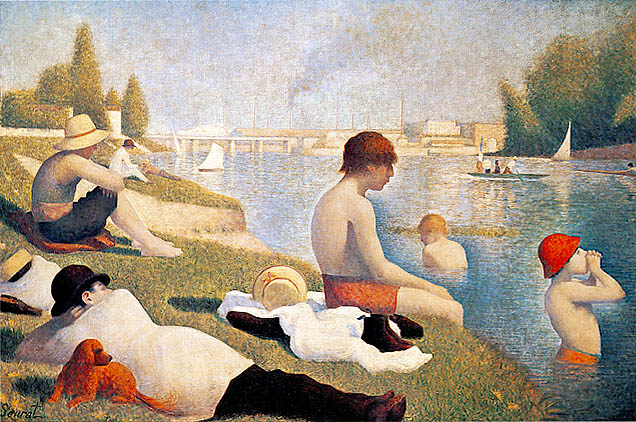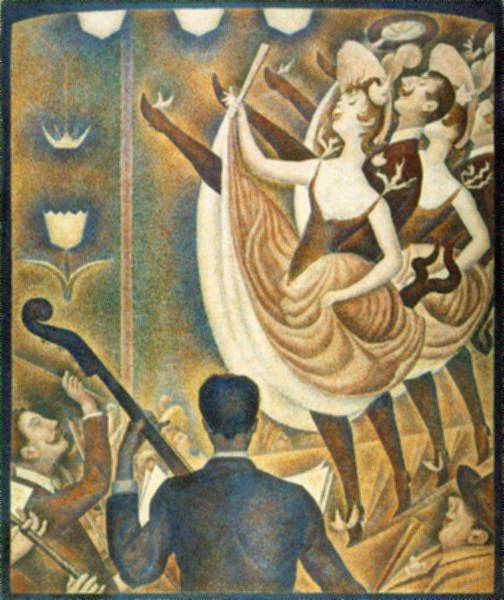Georges Pierre Seurat (2 December 1859 – 29 March 1891) was a French Post-Impressionist painter and draftsman. He is noted for his innovative use of drawing media and for devising the technique of painting known as pointillism. His large-scale work A Sunday Afternoon on the Island of La Grande Jatte (1884–1886) altered the direction of modern art by initiating Neo-impressionism. It is one of the icons of late 19th-century painting.
French painter Georges Seurat founded Neo-Impressionism and the technique of tiny strokes of contrasting color, pointillism. Seurat was not just interested in the way that the colors were put onto the painting or the painting itself. He was mostly concentrating on the science in the picture and the optical mixing of the colors. Before actually painting the picture, he would sketch out parts of his artwork so that the models would not have to wait forever while he found the exact color.
Seurat had many people who really didn't like the new work that he was introducing. They may have thought it as "fuzzy" or "messy". In their opinion it really wasn't very good at all. But there were some artists who really felt that what he was doing was very artistic and complicated.
Some of his most famous paintings include:
-A Sunday Afternoon on the Island of La Grande Jatte
-Bathing at Asnieres
-Le Chahut
A Sunday Afternoon on the Island of La Grande Jatte Story was eventually exhibited in the eighth Impressionist exhibition of May 1886.
Where exactly Seurat painted Grande Jatte is a subject of much discussion since its completion. The picturesque content of the piece has also been brought into the question because it is painted at a spot on the island which doesn't incorporate any of the increasingly apparent industry that had begun appearing on the island.
Despite the island of La Grande Jatte looking a great deal different to how it once did, Seurat's effort is perhaps the most similar to how it looks today. The banks of the river Seine are considerably steeper than in Seurat's day but one spot is convincingly similar to his Grande Jatte.
Bathing at Asnieres

This was the first of Seurat's large-scale compositions. He drew conté crayon studies for individual figures using live models, and made small oil sketcheson site which he used to help design the composition and record effects of light and atmosphere. Some 14 oil sketches and 10 drawings survive. The final composition, painted in the studio, combines information from both. The simplicity of the forms and the use of regular shapes clearly defined by light recalls paintings by the Renaissance artist Piero della Francesca. In his use of figures seen in profile, Seurat may also have been influenced by ancient Egyptian art.
Le Chahut

A frenzied gesticulation suddenly invades Seurat's art in the final two years of his life. Seurat studied and collected Jules Cheret's posters, and their compositional form is felt in Le Chahut. The curled mustache repeated in the dancer's turned-up lips, the decorations and ribbons on the dancers' shoulders and shoes, the strange similarity of male and female legs, everything here expresses the taste for peculiar detail.
This exuberance, however, does not conceal the extreme rigor of the composition. Seurat inscribes his network of diagonals on a regular geometrical background. A figure in the foreground stabilizes the composition, as one does in The Circus. Between background and foreground breaks occur. Seurat arranges in the intermediary space of Le Chahut a series of arc-shaped curves created by the dancers legs. ``Monsieur Seurat'' wrote Felix Feneon in 1889, ``knows very well that a line, independent of its representational role, has an appraisable abstract value.''
Presentation 1
Presentation 2
Film 1
Presentation 1
Presentation 2
Film 1

Your film is really informative, it seems to me that Georges Seurat was an exceptional talent who sparked a revolutionary new painting technique. In my opinion his most remarkable works are 'Study for A Sunday on La Grande Jatte' and 'The Circus'
ReplyDelete